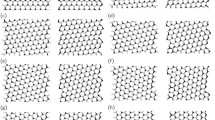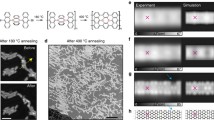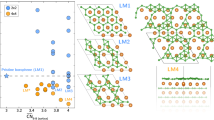Abstract
We investigated the structural, energetic, magnetic, and electronic characteristics of graphene, boron nitride, bc\(_{2}\)n nanowires, and defective nanoribbons saturated with hydrogen and fluorine atoms. The findings indicate that nanowires exhibit strong linear bonds, high formation energies, and positive phonon frequencies, thereby rendering them dynamically stable. However, saturation transforms these bonds into unstable zigzags, making them unstable. Non-saturated edges of nanoribbons have high formation energy, spin polarization, and narrow energy gaps within the band structure. We observe a reduction in the formation energy and an opening of an energy gap as a result of edge saturation in nanoribbons.
Graphical abstract










Similar content being viewed by others
Data Availability Statement
No data are associated in the manuscript.
References
Z. Zhao, B. Xu, Y. Tian, Recent advances in superhard materials. Annu. Rev. Mater. Res. 46, 383–406 (2016)
A.A. Balandin, Thermal properties of graphene and nanostructured carbon materials. Nat. Mater. 10(8), 569–81 (2011)
K.S. Novoselov, A.K. Geim, S. Morozov, D. Jiang, M. Katsnelson, I. Grigorieva et al., Two-dimensional gas of massless Dirac fermions in graphene. Nature 438(7065), 197 (2005)
K.S. Novoselov, A.K. Geim, S.V. Morozov, D. Jiang, Y. Zhang, S.V. Dubonos et al., Electric field effect in atomically thin carbon films. Science 306(5696), 666–669 (2004)
A.K. Geim, K.S. Novoselov, The rise of graphene. Nat. Mater. 6(3), 183–191 (2007). https://doi.org/10.1038/nmat1849
F. Schäffel, Chapter 2-The atomic structure of graphene and its few-layer counterparts, in Graphene. ed. by J.H. Warner, F. Schäffel, A. Bachmatiuk, M.H. Rümmeli (Elsevier, Amsterdam, 2013), pp.5–59
H. Kim, J.H. Ahn, Graphene for flexible and wearable device applications. Carbon 120(244), 257 (2017)
M. Tamagnone, C. Moldovan, J.M. Poumirol, A.B. Kuzmenko, A.M. Ionescu, J.R. Mosig et al., Near optimal graphene terahertz non-reciprocal isolator. Nat. Commun. 7(1), 11216 (2016). https://doi.org/10.1038/ncomms11216
C. Lee, X. Wei, J.W. Kysar, J. Hone, Measurement of the elastic properties and intrinsic strength of monolayer graphene. Science 321(5887), 385–388 (2008)
A. Shekhawat, R.O. Ritchie, Toughness, strength of nanocrystalline graphene. Nat. Commun. 7(1), 10546 (2016). https://doi.org/10.1038/ncomms10546
V.N. Kotov, B. Uchoa, V.M. Pereira, F. Guinea, A.H. Castro Neto, Electron–electron interactions in graphene: current status and perspectives. Rev. Mod. Phys. 84, 1067–1125 (2012). https://doi.org/10.1103/RevModPhys.84.1067
A.H. Castro Neto, F. Guinea, N.M.R. Peres, K.S. Novoselov, A.K. Geim, The electronic properties of graphene. Rev. Mod. Phys. 81, 109–162 (2009). https://doi.org/10.1103/RevModPhys.81.109
H. Murata, Y. Nakajima, N. Saitoh, N. Yoshizawa, T. Suemasu, K. Toko, High-electrical-conductivity multilayer graphene. Formed, by layer exchange with controlled thickness and interlayer. Sci. Rep. 9(1), 4068 (2019). https://doi.org/10.1038/s41598-019-40547-0
A.A. Balandin, Thermal properties of graphene and nanostructured carbon materials. Nat. Mater. 10(8), 569–581 (2011). https://doi.org/10.1038/nmat3064
M. Corso, W. Auwärter, M. Muntwiler, A. Tamai, T. Greber, J. Osterwalder, Boron nitride nanomesh. Science 303(5655), 217–220 (2004). https://doi.org/10.1126/science.1091979
J. Yin, J. Li, Y. Hang, J. Yu, G. Tai, X. Li et al., Boron nitride nanostructures: fabrication, functionalization and applications. Small 12(22), 2942–2968 (2016). https://doi.org/10.1002/smll.201600053
J.E. Jacak, Phase diagrams for superfluidity of indirect excitons in double Hall systems GaAs, GaAlAs, GaAs and bilayer-graphene, hBN, bilayer-graphene. Europhys. Lett. 123(1), 16001 (2018). https://doi.org/10.1209/0295-5075/123/16001
F. Amet, A.J. Bestwick, J.R. Williams, L. Balicas, K. Watanabe, T. Taniguchi et al., Composite fermions and broken symmetries in graphene. Nat. Commun. 6(1), 5838 (2015). https://doi.org/10.1038/ncomms6838
J.I.A. Li, T. Taniguchi, K. Watanabe, J. Hone, C.R. Dean, Excitonic superfluid phase in double bilayer graphene. Nat. Phys. 13(8), 751–755 (2017). https://doi.org/10.1038/nphys4140
M.O. Goerbig, Electronic properties of graphene in a strong magnetic field. Rev. Mod. Phys. 83, 1193–243 (2011). https://doi.org/10.1103/RevModPhys.83.1193
S. Fukamachi, P. Solís-Fernández, K. Kawahara, D. Tanaka, T. Otake, Y.C. Lin et al., Large-area synthesis and transfer of multilayer hexagonal boron nitride for enhanced graphene device arrays. Nat. Electron. 6(2), 126–136 (2023). https://doi.org/10.1038/s41928-022-00911-x
P. Łydżba, L. Jacak, J. Jacak, Hierarchy of fillings for the FQHE in monolayer graphene. Sci. Rep. 5(1), 14287 (2015). https://doi.org/10.1038/srep14287
Y.M. Banadaki, S. Sharifi, Graphene Nanostructures: Modeling, Simulation, and Applications in Electronics and Photonics (CRC Press, Boca Raton, 2019)
T.H. Seo, W. Lee, K.S. Lee, J.Y. Hwang, D.I. Son, S. Ahn et al., Dominant formation of h-BC2N in h-BxCyNz films: CVD synthesis and characterization. Carbon 182, 791–798 (2021)
J. Gubicza, Defect Structure in Nanomaterials (Elsevier, Amsterdam, 2012)
Q. Fan, L. Yan, M.W. Tripp, O. Krejčí, S. Dimosthenous, S.R. Kachel et al., Biphenylene network: a nonbenzenoid carbon allotrope. Science 372(6544), 852–856 (2021). https://doi.org/10.1126/science.abg4509
M. Liu, C.L. Yang, M.S. Wang, X.G. Ma, Halogen edge-passivated antimonene nanoribbons for photocatalytic hydrogen evolution reaction with high solar-to-hydrogen conversion. J. Phys. Chem. C 125(39), 21341–2151 (2021). https://doi.org/10.1021/acs.jpcc.1c06614
J. Lahiri, Y. Lin, P. Bozkurt, I.I. Oleynik, M. Batzill, An extended defect in graphene as a metallic wire. Nat. Nanotechnol. 5(5), 326–329 (2010). https://doi.org/10.1038/nnano.2010.53
H.J. Park, J. Cha, M. Choi, J.H. Kim, R.Y. Tay, E.H.T. Teo et al., One-dimensional hexagonal boron nitride conducting channel. Sci. Adv. 6(10), eaay4958 (2020). https://doi.org/10.1126/sciadv.aay4958
D. Sánchez-Portal, P. Ordejón, E. Artacho, J.M. Soler, Density-functional method for very large systems with LCAO basis sets. Int. J. Quantum Chem. 65(5), 453–461 (1997). https://doi.org/10.1002/(SICI)1097-461X(1997)65:5<453::AID-QUA9>3.0.CO;2-V
J.M. Soler, E. Artacho, J.D. Gale, A. García, J. Junquera, P. Ordejón, The SIESTA method for ab initio order-N materials simulation. J. Phys. Condens. Matter 14(11), 2745 (2002). https://doi.org/10.1088/0953-8984/14/11/302
P. Hohenberg, W. Kohn, Inhomogeneous electron gas. Phys. Rev. 136, B864–B871 (1964). https://doi.org/10.1103/PhysRev.136.B864
W. Kohn, L.J. Sham, Self-consistent equations including exchange and correlation effects. Phys. Rev. 140, A1133–A1138 (1965). https://doi.org/10.1103/PhysRev.140.A1133
J.P. Perdew, K. Burke, M. Ernzerhof, Generalized gradient approximation made simple. Phys. Rev. Lett. 77(18), 3865–8 (1996)
N. Troullier, J.L. Martins, Efficient pseudopotentials for plane-wave calculations. Phys. Rev. B 43, 1993–2006 (1991). https://doi.org/10.1103/PhysRevB.43.1993
S.S. Alexandre, H. Chacham, R.W. Nunes, Structure and energetics of boron nitride fullerenes: the role of stoichiometry. Phys. Rev. B. 63, 045402 (2001). https://doi.org/10.1103/PhysRevB.63.045402
S. Azevedo, M.S.C. Mazzoni, R.W. Nunes, H. Chacham, Stability of antiphase line defects in nanometer-sized boron nitride cones. Phys. Rev. B 70, 205412 (2004). https://doi.org/10.1103/PhysRevB.70.205412
D. Silva, S. Azevedo, J.R. Kaschny, Structural and electronic properties of fluorinated boron nitride monolayers. Eur. Phys. J. B. 94(1), 2 (2021)
M.M. Deza, E. Deza (Springer, Berlin, 2009), p. 1-583. https://doi.org/10.1007/978-3-642-00234-2_1
J.A. Januszewski, R.R. Tykwinski, Synthesis and properties of long cumulenes. Chem. Soc. Rev. 43, 3184–203 (2014). https://doi.org/10.1039/C4CS00022F
J. Lawrence, A. Berdonces-Layunta, S. Edalatmanesh, J. Castro-Esteban, T. Wang, A. Jimenez-Martin et al., Circumventing the stability problems of graphene nanoribbon zigzag edges. Nat. Chem. 14(12), 1451–1458 (2022). https://doi.org/10.1038/s41557-022-01042-8
B. Mortazavi, I.S. Novikov, E.V. Podryabinkin, S. Roche, T. Rabczuk, A.V. Shapeev et al., Exploring phononic properties of two-dimensional materials using machine learning interatomic potentials. Appl. Mater. Today 20, 100685 (2020)
U. Argaman, G. Makov, Carbon nanowires under compression and their vibrational anomalies. Nanoscale Adv. 4, 2996–3009 (2022). https://doi.org/10.1039/D2NA00027J
D. Cahen, A. Kahn, Electron energetics at surfaces and interfaces: concepts and experiments. Adv. Mater. 15(4), 271–7 (2003)
F. Djurabekova, A. Ruzibaev, E. Holmström, S. Parviainen, M. Hakala, Local changes of work function near rough features on Cu surfaces operated under high external electric field. J. Appl. Phys. 114(24), 1–8 (2013)
G. Shao, Work function and electron affinity of semiconductors: doping effect and complication due to Fermi level pinning. Energy Environ. Mater. 4(3), 273–6 (2021)
A. Kahn, Fermi level, work function and vacuum level. Mater. Horiz. 3(1), 7–10 (2016)
Acknowledgements
We would like to thank the financial support provided by the Brazilian Agencies CNPq (scholarship 151333/2022-0), CAPES and Pronex-Fapesq/PB-MCT/CNPq (Grants 006/2018 and 151/2018).
Author information
Authors and Affiliations
Contributions
TG involved in investigation, visualization, project administration, writing, review, and validation. JMP involved in investigation, visualization, and writing. AKMP involved in review and writing. DSG involved in investigation, visualization, and writing. SA involved in review, validation, project administration, and supervision.
Corresponding author
Ethics declarations
Conflict of interest
The authors declare that there is no conflict of interest, financial, or otherwise.
Additional information
Publisher's Note
Springer Nature remains neutral with regard to jurisdictional claims in published maps and institutional affiliations.
Rights and permissions
Springer Nature or its licensor (e.g. a society or other partner) holds exclusive rights to this article under a publishing agreement with the author(s) or other rightsholder(s); author self-archiving of the accepted manuscript version of this article is solely governed by the terms of such publishing agreement and applicable law.
About this article
Cite this article
Guerra, T., Pinto, A.K.M., Pontes, J.M. et al. Hydrogenation and fluorination of graphene, boron nitride, bc\(_{2}\)n nanowires and nanoribbons with defects via DFT. Eur. Phys. J. Plus 138, 1033 (2023). https://doi.org/10.1140/epjp/s13360-023-04667-x
Received:
Accepted:
Published:
DOI: https://doi.org/10.1140/epjp/s13360-023-04667-x




